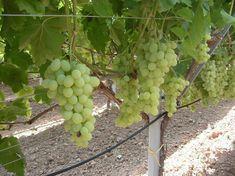
Early Sweet came out of the well-established Grapa breeding programme in the early 1990s as the result of many years spent cross-breeding varieties to complement the mainstays Sugraone, Perlette and Thompson at the extremities of the production seasons around the world. “There was no real point developing a new variety to compete directly with those varieties,” says Nomi Karniel-Padan, director of Grapa and fifth generation of the family business. “So we were looking for something that combined all the desired characteristics in terms of consistent flavour, eating quality, production performance and shelf-life, but was available to the market at either the beginning or end of the season.”
Trials were carried out in several production regions, mainly in Israel, Spain, Morocco and Italy, and it became clear that Grapaes, or Early Sweet, had the potential to enter the market a week before Perlette and at least two before Sugraone. That would theoretically allow buyers to make the switch from one source to another without the need to rely on end-of-season fruit that could not match the quality of what preceded it and disrupt the flow of the market.
Once the potential for the variety was recognised, the next step was to obtain Protected Breeders Rights for Early Sweet, before upping plantings to commercial levels. That began in 1999 and in Israel it proved a two-year process. In the EU however, poor weather in consecutive years in UPOV test blocks in Italy hindered progress of trial sites and delayed the evaluation job to the end of 2005. It took five years to remove all the obstacles, but in 2005, the first substantial volumes of the fruit were seen in the UK.
“We chose our growers very carefully,” says Karniel-Padan. “We have not attempted to expand the variety too quickly, or all over the world. At all times, we have recognised the need to strike the right balance between volume and realising a premium.”
To date, growers have been enlisted, in Agadir and Marrakech, Morocco, in the Jordan Valley in Israel, southern Spain, Italy, Tunisia and the US. Production could also soon be underway in Australia, Egypt and South Africa. The variety has performed well in every region so far and there has been a calculated attempt to find areas that fit into the existing supply calendar. “There is no point putting a new variety into the August to October window, when the market is full of grapes,” she says. “There is nothing to be gained for growers from providing grapes at that time.”
Grapa has highlighted mid-May to mid June as the critical time in the UK market. There are still grapes in the market from the southern hemisphere, but Karniel-Padan says UK importers are looking around at that time for fresh, new-season grape and have found it hard to come by. “This is a time when the market has historically been short of high quality, fresh grapes and it is possible to obtain good prices. Everyone around the world has been trying to extend the shoulders of the seasons of existing varieties, but to have a variety that performs well at its natural time is a big advantage.”
While the earliness is a major plus, a variety cannot live on that alone. “If you try and market an early grape that tastes like a cucumber, you are not doing your job right. Early Sweet - when ripe - has the flavour of Muscat, it is fairly crispy and has the creamy colour liked by the market. There are some similarities with Prime, but we believe the difference is that Early Sweet will consistently outperform Prime on-shelf,” she says.
The UK market has reacted favourably to the variety. “Now that people can see the volume availability is there and the advantages of Early Sweet become clearer, its value will increase dramatically,” Karniel-Padan says.
“2005 went very well and when I visited in September, Marks & Spencer said that Early Sweet had been one of the success stories of the year for its grape category. Demand was high and prices were good for growers, so the variety worked for all parties. There will definitely be more volume available for the UK market next year as more product in Morocco and Israel, and also Spain comes on stream. Most Spanish-grown product went to Germany this year and was well received there too.”
South African product will begin to come through in 2007, as the southern-hemisphere plantings begin to bear fruit and the final goal of plugging the year-round gaps looms into view. “We have shown that Early Sweet can compete very well in the early window against tired fruit from other sources and even new-season fruit that is not quite ready for marketing and the growers in the northern hemisphere are very happy so far. From 2007 on, we will see what impact the variety can have at different points in the calendar,” says Karniel-Padan.
“When the variety is recognised by consumers and more doors open, our responsibility as the variety owner expands on both sides of the enforcement equation; both registration and monitoring of the breeder plant rights aspect and assuring control and vigilance to prevent illegal grapes arriving on the market. This is our basic and primary obligation to our growers. The new policy of UK chain stores is to ask for legal certificates of authorisation from the exporter and variety owner before marketing grapes; we believe that this is a great move for the future.”



